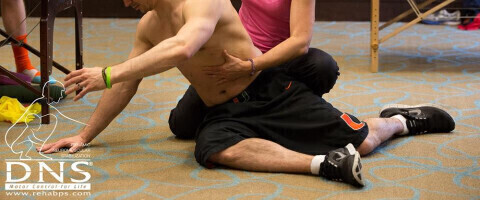The nervous system establishes programs that control human posture, movement and gait. This ‘motor control’ is largely established during the first critical years of life. Therefore, the “Prague School” emphasizes neurodevelopmental aspects of motor control in order to assess and restore dysfunction of the locomotor system and associated syndromes.
The “Prague School” of Rehabilitation and Manual Medicine was established by key neurologists/physiatrists, all of whom were giants in the 20th Century rehabilitation movement: Professors’ Vaclav Vojta, Karel Lewit, Vladimir Janda, and Frantisek Vele.
Based upon the groundbreaking neurodevelopmental and rehabilitation principles described by these mentors, Pavel Kolar has organized the next generation of clinical protocols that are designed to restore and stabilize locomotor function. This new rehabilitation approach is called Dynamic Neuromuscular Stabilization (DNS).
Course objectives DNS A
•Improve understanding of the basic principles of developmental kinesiology with an emphasis on development during the first year of life
•Identify and describe key milestones in human development
•Introduce the three level of sensorimotor control in functional assessment and treatment
•Demonstrate the relationship between development during the first year of life and pathology of the locomotor system in adulthood
•Introduce new terminology pertinent to rehabilitation such as functional joint centration, punctum fixum, punctum mobile and the integrated stabilizing system of the spine
•Define ideal postural stabilization from a developmental perspective: intra-abdominal pressure regulation, dual role of the diaphragm in stabilization and respiration, stabilization via co-contraction
•Identify common stereotypes of faulty postural stabilization (“open scissors syndrome”, forward drown posture, backward drown posture, “hour glass syndrome”)
•Explain and demonstrate biomechanics of undifferentiated, ipsilateral and contralateral postural-locomotion patterns; closed and opened kinematic chains, stepping forward and supporting function
•Evaluate and correct poor respiratory patterns
•Demonstrate the correlation between poor respiration patterns and functional pathology of the locomotor system
•Assess the integrated stabilizing system of the spine both visually and utilizing dynamic functional tests
•Integrate corrective exercises based on the DNS functional tests and developmental positions: exercise in undifferentiated static positions; position transfer during locomotor function; exercise progression using unstable surfaces; increased difficulty of the exercises utilizing resistance, dual tasking and other challenges
•Clarify how DNS corrective exercises can integrate with other exercise strategies
•Cover the basics of application of DNS concept in sport training
•Provide basic clinical management explanation for clinicians to better integrate the DNS approach in their regular practice, including patient education
•Optimally prepare students for the next level of training (Course “B”)
Cursus planning
- 08:30 - 09:00: Registratie met koffie en thee
